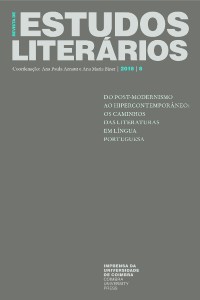Please use this identifier to cite or link to this item:
https://hdl.handle.net/10316.2/45164| Title: | Algum lugar, de Paloma Vidal: deslocamento, estranhamento e melancolia | Other Titles: | Someplace (Algum lugar) by Paloma Vidal: displacement, strangeness and melancholy | Authors: | Mello, Ana Maria Lisboa de | Keywords: | contemporary cities;displacement;strangeness;disagreements;existential crisis;melancholy;cidades contemporâneas;deslocamento;estranhamento;desencontros;crises existenciais;melancolia | Issue Date: | 2018 | Publisher: | Imprensa da Universidade de Coimbra | Abstract: | In the Brazilian contemporary novel, especially since the 1990s, movements
and spatial changes of characters who, temporarily in other countries and
cultures, face loneliness, estrangement and the search for themselves, are
recurring. Taking this into account, the novel Someplace (Algum Lugar)
by Paloma Vidal has been analyzed. The protagonist and her companion
move from Rio de Janeiro to fulfi l a research internship in Los Angeles.
The American city, symbolized by large avenues, the lack people, and the
supremacy of the automobile, portrays a hostile image, similar to the “nonplace”,
characterized by Marc Augé. The city is the portrait of a world
that has become hostile to human conviviality; the configuration of the city
suppresses the possibility of any encounter, a fact that tears the individual
apart. Increasingly alone, exiled from herself, the protagonist is divided
between the dream and the devouring reality and inhabited by an indefinite
absence, an existential void. São recorrentes, no romance brasileiro contemporâneo, sobretudo a partir da década de 1990, deslocamentos e mudanças espaciais de personagens que, situados temporariamente em outros países e culturas, enfrentam a solidão, o estranhamento e empreendem a busca de si mesmos. Nessa perspectiva, analisamos o romance Algum lugar (2009), de Paloma Vidal. A protagonista e seu companheiro deslocam-se do Rio de Janeiro para cumprir estágio de pesquisa em Los Angeles. A cidade norte-americana, com grandes avenidas, vazias de pessoas, e supremacia do automóvel, mostra-se hostil, semelhante ao “não-lugar”, caracterizado por Marc Augé. A cidade é o retrato de um mundo que se tornou hostil ao convívio humano; a configuração da cidade suprime a possibilidade do encontro, fato que dilacera o indivíduo, cada vez mais só, exilado de si mesmo, dividido entre o sonho e a realidade devoradora e habitado por uma falta indefinida, um vazio existencial. |
URI: | https://hdl.handle.net/10316.2/45164 | ISSN: | 2182-1526 2183-847X (PDF) |
DOI: | 10.14195/2183-847X_8_13 | Rights: | open access |
| Appears in Collections: | Revista de Estudos Literários |
Files in This Item:
| File | Description | Size | Format | |
|---|---|---|---|---|
| algum_lugar__de_paloma_vidal.pdf | 154.87 kB | Adobe PDF |  |
Items in DSpace are protected by copyright, with all rights reserved, unless otherwise indicated.
